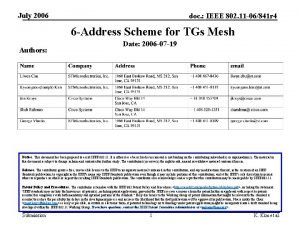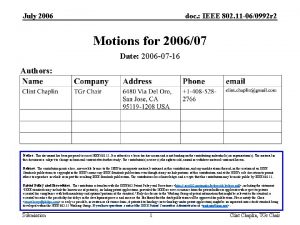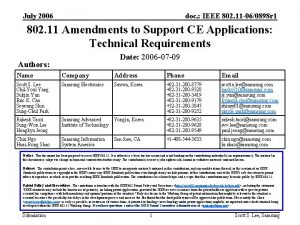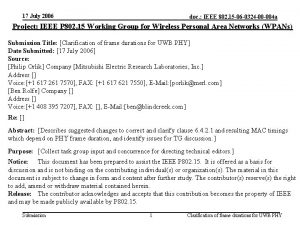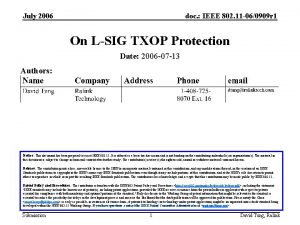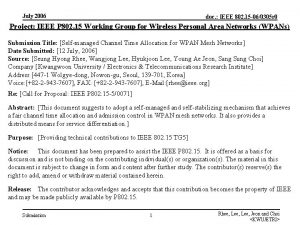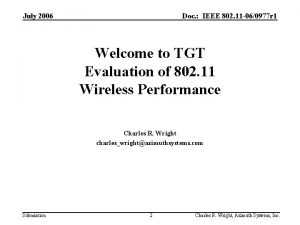July 2006 doc IEEE 802 11 060975 r













- Slides: 13

July 2006 doc. : IEEE 802. 11 -06/0975 r 1 Dynamic signaling of parameter for target network behavior and operation Date: 2006 -07 -18� Authors: Name Company Address Phone email Marc Emmelmann Technical University Berlin Einsteinufer 25 10587 Berlin, Germany +49 -30 -31424580 emmelmann@ieee. org Berthold Rathke Technical University Berlin Einsteinufer 25 10587 Berlin, Germany +49 -30 -31434832 rathke@tkn. tu-berlin. de Notice: This document has been prepared to assist IEEE 802. 11. It is offered as a basis for discussion and is not binding on the contributing individual(s) or organization(s). The material in this document is subject to change in form and content after further study. The contributor(s) reserve(s) the right to add, amend or withdraw material contained herein. Release: The contributor grants a free, irrevocable license to the IEEE to incorporate material contained in this contribution, and any modifications thereof, in the creation of an IEEE Standards publication; to copyright in the IEEE’s name any IEEE Standards publication even though it may include portions of this contribution; and at the IEEE’s sole discretion to permit others to reproduce in whole or in part the resulting IEEE Standards publication. The contributor also acknowledges and accepts that this contribution may be made public by IEEE 802. 11. Patent Policy and Procedures: The contributor is familiar with the IEEE 802 Patent Policy and Procedures <http: // ieee 802. org/guides/bylaws/sb-bylaws. pdf>, including the statement "IEEE standards may include the known use of patent(s), including patent applications, provided the IEEE receives assurance from the patent holder or applicant with respect to patents essential for compliance with both mandatory and optional portions of the standard. " Early disclosure to the Working Group of patent information that might be relevant to the standard is essential to reduce the possibility for delays in the development process and increase the likelihood that the draft publication will be approved for publication. Please notify the Chair <stuart. kerry@philips. com> as early as possible, in written or electronic form, if patented technology (or technology under patent application) might be incorporated into a draft standard being developed within the IEEE 802. 11 Working Group. If you have questions, contact the IEEE Patent Committee Administrator at <patcom@ieee. org>. Submission 1 Marc Emmelmann, Technical University Berlin

July 2006 doc. : IEEE 802. 11 -06/0975 r 1 Abstract TGv works on a coherent network management interface specifying several capabilities to achieve this goal. In a heterogeneous operator or vendor environment, several vendors or operators may optimize their network for different requirements. It could be expected, that different optimization goals hinder each other and may not lead to optimal network behavior which may cause poor performance or even a collapse of the network. Having knowledge of these different optimization goals can be used to improve network performance or even avoid the network to collapse. This presentation is intended to start a discussion in TGv to elaborate if this further information should be distributed using 802. 11 protocol mechanisms. Submission 2 Marc Emmelmann, Technical University Berlin

July 2006 doc. : IEEE 802. 11 -06/0975 r 1 Motivation • Status Quo: – Goal: complete a coherent upper layer interface for network management (. 11 v PAR) – objectives specify required capabilities, e. g. : • spectrum etiquette / dynamic power control (Req 2041) • dynamic channel selection (Req 2000) but the reason for employing these mechanisms will not be standardized • Result: – Each vendor may use these management interfaces / capabilities and employ its own algorithms to for network and resource management – Different algorithms having the same aim may different in their performance and the “quality” of the result – These algorithms characterizes the maturity of each vendor’s product and should not be covered in the standard, but. . . • Problem: Algorithms with different aims may hinder each other and may cause poor performance or even the collapse of the network Submission 3 Marc Emmelmann, Technical University Berlin

July 2006 doc. : IEEE 802. 11 -06/0975 r 1 Example 1 -- Ordering Names • Sort the following names: Tim, Adam, John, Bob, Peter • Several algorithms exist to sort these name, one are more efficient, others are not, e. g. : – Vendor A applies algorithm A – Vendor B applies algorithm B • Problem: What happens if the two vendors do not agree on the sorting order (alphabetically increasing or decreasing) • Imagine if only the top three in the list get a promotion and the others are fired. . . only John won’t care : -) Submission 4 Marc Emmelmann, Technical University Berlin

July 2006 doc. : IEEE 802. 11 -06/0975 r 1 Example 2 -- Optimization of Cell Size • Goal: Optimize Cell Size • Employed Mechanism: Spectrum Etiquette / Dynamic Power Ctrl. • Criteria: – Vendor A tries to reduce interference – Vendor B tries to maximize network coverage • What could happen? Submission 5 Marc Emmelmann, Technical University Berlin

July 2006 doc. : IEEE 802. 11 -06/0975 r 1 Min. Interference VS. Max. Coverage APs have adjusted cell size to minimize interference AP AP joins and maximizes coverage area employing medium Tx power APs detect interference and reduce cell size APs further increases Tx power to ensure contineous coverage AP AP § AP AP APs detect interference and further reduce cell size Is this the desired behavior? Maybe, maybe not. But this will happen regardless of the employed algorithm at each AP. Submission 6 Marc Emmelmann, Technical University Berlin

July 2006 doc. : IEEE 802. 11 -06/0975 r 1 Solution: Signaling of Optimization Criteria • If the optimization criteria (max. coverage or min. interference) was signaled, each AP had some idea on the possible behavior of others. • What could happen? – Vendor specific algorithm does not use this information --> nothing gained but also nothing lost (this is what we have) – Some vendors use this algorithm: • The “green” now knows that they can never reach optimal (zero) interference and may act accordingly. • The “red” now knows that others optimize for reduced interference and may change its algorithm or even the optimization criteria. Submission 7 Marc Emmelmann, Technical University Berlin

July 2006 doc. : IEEE 802. 11 -06/0975 r 1 Partial use of knowledge: Adapt min. interference criteria APs have adjusted cell size to minimize interference AP AP joins and maximizes coverage area employing medium Tx power APs detect interference but know that the source is an AP optimizing for network coverage AP APs might accept a region of interference and a do not decrease cell size AP § AP AP Vendor-specific behavior of employed algorithm Submission 8 Marc Emmelmann, Technical University Berlin

July 2006 doc. : IEEE 802. 11 -06/0975 r 1 Partial use of knowledge: Adapt max. network coverage criteria APs have adjusted cell size to minimize interference AP AP joins and maximizes coverage area employing medium Tx power APs detect interference and reduce cell size APs do not further increases Tx power but accept limited coverage AP AP § AP AP Vendor-specific behavior of employed algorithm Submission 9 Marc Emmelmann, Technical University Berlin

July 2006 doc. : IEEE 802. 11 -06/0975 r 1 Agreement on Optimization Criteria • All APs have knowledge on the other’s behavior and may try to negotiate a common optimization criteria – They do not agree on a common criteria --> noting gained but also nothing lost – They agree either on interference reduction or coverage optimization Submission 10 Marc Emmelmann, Technical University Berlin

July 2006 doc. : IEEE 802. 11 -06/0975 r 1 Conclusion • Providing only mechanisms for network management may result in unintended network behavior as different vendors might use them for different purposes employing different criteria • Distributing information on these criteria may help to deal with this problem and should be made available using 11 v mechanisms • Further improvement: Mechanisms to reach an agreement on a common criteria • Possible TGv objectives that could address this issue: – – Submission Client Management Protocol (Req 1500) Access Point Coordination (Req 2050) Advertisement (Req 1300) other ? 11 Marc Emmelmann, Technical University Berlin

July 2006 doc. : IEEE 802. 11 -06/0975 r 1 Discussion • Feasibility to – announce how capabilities 11 v devices are used, i. e. , the “aim” / optimization criteria – provide schemes to negotiate / agree on common “aim” • Possible TGv objectives that could address this issue: – – Submission Client Management Protocol (Req 1500) Access Point Coordination (Req 2050) Advertisement (Req 1300) other ? 12 Marc Emmelmann, Technical University Berlin

July 2006 doc. : IEEE 802. 11 -06/0975 r 1 References • P 802. 11 v-D 0. 03 • 11 -06/827 r 3 Submission 13 Marc Emmelmann, Technical University Berlin
















